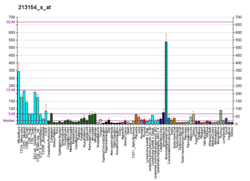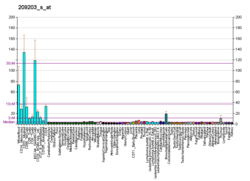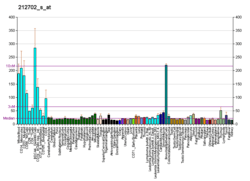BICD2
Protein bicaudal D homolog 2 is a protein that in humans is encoded by the BICD2 gene.[3][4]
This gene is one of two human homologs of Drosophila bicaudal-D and a member of the Bicoid family. It has been implicated in dynein-mediated, minus end-directed motility along microtubules. It has also been reported to be a phosphorylation target of NIMA related kinase 8. Two alternative splice variants have been described.[4]
References
- ↑ "Human PubMed Reference:".
- ↑ "Mouse PubMed Reference:".
- ↑ Ishikawa K, Nagase T, Suyama M, Miyajima N, Tanaka A, Kotani H, Nomura N, Ohara O (Dec 1998). "Prediction of the coding sequences of unidentified human genes. X. The complete sequences of 100 new cDNA clones from brain which can code for large proteins in vitro". DNA Res. 5 (3): 169–76. PMID 9734811. doi:10.1093/dnares/5.3.169.
- 1 2 "Entrez Gene: BICD2 bicaudal D homolog 2 (Drosophila)".
External links
- Human BICD2 genome location and BICD2 gene details page in the UCSC Genome Browser.
Further reading
- Hoogenraad CC, Akhmanova A, Howell SA, et al. (2001). "Mammalian Golgi-associated Bicaudal-D2 functions in the dynein–dynactin pathway by interacting with these complexes". EMBO J. 20 (15): 4041–54. PMC 149157
 . PMID 11483508. doi:10.1093/emboj/20.15.4041.
. PMID 11483508. doi:10.1093/emboj/20.15.4041. - Holland PM, Milne A, Garka K, et al. (2002). "Purification, cloning, and characterization of Nek8, a novel NIMA-related kinase, and its candidate substrate Bicd2". J. Biol. Chem. 277 (18): 16229–40. PMID 11864968. doi:10.1074/jbc.M108662200.
- Short B, Preisinger C, Schaletzky J, et al. (2003). "The Rab6 GTPase regulates recruitment of the dynactin complex to Golgi membranes". Curr. Biol. 12 (20): 1792–5. PMID 12401177. doi:10.1016/S0960-9822(02)01221-6.
- Matanis T, Akhmanova A, Wulf P, et al. (2003). "Bicaudal-D regulates COPI-independent Golgi-ER transport by recruiting the dynein-dynactin motor complex". Nat. Cell Biol. 4 (12): 986–92. PMID 12447383. doi:10.1038/ncb891.
- Strausberg RL, Feingold EA, Grouse LH, et al. (2003). "Generation and initial analysis of more than 15,000 full-length human and mouse cDNA sequences". Proc. Natl. Acad. Sci. U.S.A. 99 (26): 16899–903. PMC 139241
 . PMID 12477932. doi:10.1073/pnas.242603899.
. PMID 12477932. doi:10.1073/pnas.242603899. - Hoogenraad CC, Wulf P, Schiefermeier N, et al. (2004). "Bicaudal D induces selective dynein-mediated microtubule minus end-directed transport". EMBO J. 22 (22): 6004–15. PMC 275447
 . PMID 14609947. doi:10.1093/emboj/cdg592.
. PMID 14609947. doi:10.1093/emboj/cdg592. - Brill LM, Salomon AR, Ficarro SB, et al. (2004). "Robust phosphoproteomic profiling of tyrosine phosphorylation sites from human T cells using immobilized metal affinity chromatography and tandem mass spectrometry". Anal. Chem. 76 (10): 2763–72. PMID 15144186. doi:10.1021/ac035352d.
- Humphray SJ, Oliver K, Hunt AR, et al. (2004). "DNA sequence and analysis of human chromosome 9". Nature. 429 (6990): 369–74. PMC 2734081
 . PMID 15164053. doi:10.1038/nature02465.
. PMID 15164053. doi:10.1038/nature02465. - Beausoleil SA, Jedrychowski M, Schwartz D, et al. (2004). "Large-scale characterization of HeLa cell nuclear phosphoproteins". Proc. Natl. Acad. Sci. U.S.A. 101 (33): 12130–5. PMC 514446
 . PMID 15302935. doi:10.1073/pnas.0404720101.
. PMID 15302935. doi:10.1073/pnas.0404720101. - Gerhard DS, Wagner L, Feingold EA, et al. (2004). "The Status, Quality, and Expansion of the NIH Full-Length cDNA Project: The Mammalian Gene Collection (MGC)". Genome Res. 14 (10B): 2121–7. PMC 528928
 . PMID 15489334. doi:10.1101/gr.2596504.
. PMID 15489334. doi:10.1101/gr.2596504. - Rush J, Moritz A, Lee KA, et al. (2005). "Immunoaffinity profiling of tyrosine phosphorylation in cancer cells". Nat. Biotechnol. 23 (1): 94–101. PMID 15592455. doi:10.1038/nbt1046.
- Fuchs E, Short B, Barr FA (2006). "Assay and properties of rab6 interaction with dynein-dynactin complexes". Meth. Enzymol. 403: 607–18. PMID 16473624. doi:10.1016/S0076-6879(05)03053-3.
- Beausoleil SA, Villén J, Gerber SA, et al. (2006). "A probability-based approach for high-throughput protein phosphorylation analysis and site localization". Nat. Biotechnol. 24 (10): 1285–92. PMID 16964243. doi:10.1038/nbt1240.
- Olsen JV, Blagoev B, Gnad F, et al. (2006). "Global, in vivo, and site-specific phosphorylation dynamics in signaling networks". Cell. 127 (3): 635–48. PMID 17081983. doi:10.1016/j.cell.2006.09.026.
This article is issued from
Wikipedia.
The text is licensed under Creative Commons - Attribution - Sharealike.
Additional terms may apply for the media files.


